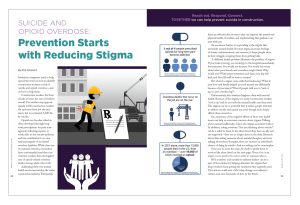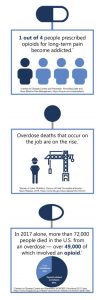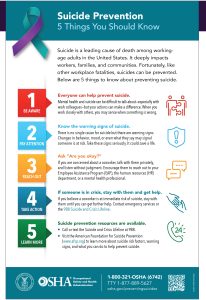Suicide and Opioid Overdose: Prevention Starts with Reducing Stigma
Insulation companies need to help spread the word on how to identify construction workers at risk of suicide and opioid overdose—and on how to help them.
Construction workers die from suicide at twice the rate of workers overall. Put another way, approximately 1,000 construction workers die each year from job site incidents, but an estimated 5,200 die by suicide.
Opioid use disorder, which is often developed through long-term prescriptions for pain management following injuries at work, adds to the suicide epidemic and has contributed to its own national tragedy of accidental overdose fatalities. While there are no national statistics, researchers have consistently found that construction workers have the highest rate of opioid-related overdose deaths among adults who work.
Addressing these two mental health needs must involve the entire construction industry. Fortunately, there are effective, free resources that can improve the mental and physical health of workers, and implementing that guidance can start with you.
An enormous barrier to responding is the stigma that surrounds mental health. Because stigma increases feelings of shame, embarrassment, and remorse, it keeps people alone in their struggle, stopping them from getting help.
A different health problem illustrates the problem of stigma. If you broke your leg, you would go to the hospital immediately for treatment. You would not hesitate. You would not worry about what your friends and coworkers might think. Why would you? With proper treatment and time, your leg will heal, and then life will be back to normal.
But what if a stigma came with that broken leg? What if your boss and family judged you and treated you differently because of your injury? What if people told you to “suck it up, it’s just a broken leg”?
Unfortunately, this situation happens often with mental health. Because of the stigma, too many construction workers “suck it up” and do not seek the mental health care they need. This stigma can be so powerful that it makes people reluctant to address suicide and opioid use, even though each deeply affects those around us.
Yet, awareness of the negative effects of those two health issues can help us overcome concerns about stigma. Talking about mental health helps reduce the stigma associated with it. In addition, asking someone, “Are you thinking about suicide?” can be a relief to them. It lets them know they have an ally and are supported—they are no longer alone in the dark. Research shows that asking someone about suicidal thoughts, and even talking about those thoughts, does not increase an individual’s chance of dying by suicide. And not asking can be catastrophic.
Once you do raise the topic, be ready to guide them to services like those listed on the next page. None of us is an expert, so we need to be sure to refer to someone who is.
NIA members and insulation industry leaders can be a part of the solution by helping eliminate the stigma that keeps workers from getting the treatment they urgently need. Your actions could save a life today, change our industry’s culture, and save thousands of lives in the future.
Resources

There are many resources that can be utilized if you or a fellow worker need help with thoughts of self-harm, suicidal thoughts, or opioid use disorder.
The National Suicide Prevention Lifeline is now 988. In an emergency that involves a mental health crisis, call 988 instead of 911.
CIASP: The Construction Industry Alliance for Suicide Prevention has resources for teaching their STAND UP for Suicide Prevention model, as well as links to other trainings.
The Center for Construction Research and Training (CPWR) website includes a toolbox talk, hazard alert, and infographics pertaining to suicide awareness and opioid use prevention.
Finally, if someone is interested in treatment for suicidal ideation, mental health, or substance use disorder, check with the company’s employee assistance program, if there is one, or go to the SAMHSA treatment locator to search for treatment in your area (it includes a search by health plan coverage).
References
1. Blades, C.A., Stritzke, W.G.K., Page, A.C., Brown, J.D., “The benefits and risks of asking research participants about suicide: A meta-analysis of
the impact of exposure to suicide-related content,” Clin Psychol Rev.,
2018 Aug., 64:1-12.
2. Dong et al., 2021, “Fatal injury trends in the construction industry,”
CPWR Data Bulletin, Silver Spring, MD.
3. Massachusetts Department of Public Health Occupational Health Surveillance Program (2021), “Opioid-related Overdose Deaths in Massachusetts by Industry and Occupation, 2016-2017,” Boston. Retrieved from:https://www.mass.gov/doc/opioid-related-overdose-deaths-by-industry-and-occupation-2016- 2017/download
4. Peterson et al., “Suicide Rates by Industry and Occupation – National Violent Death Reporting System, 32 States,” 2016, Morbidity and Mortality Weekly Report, CDC, 2020, 69: 57-62.



